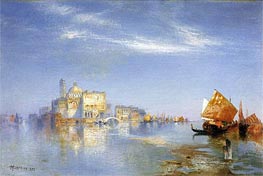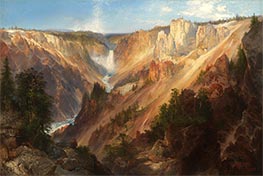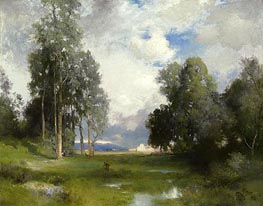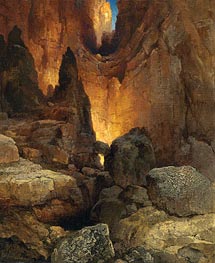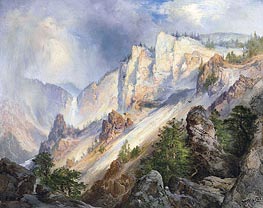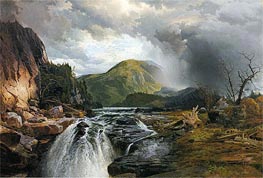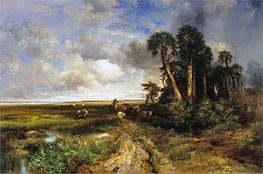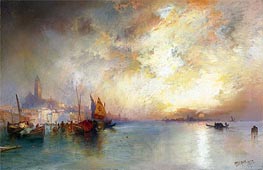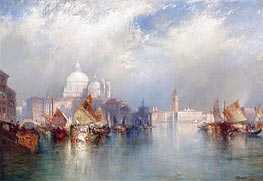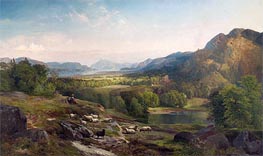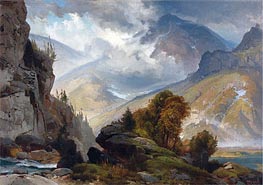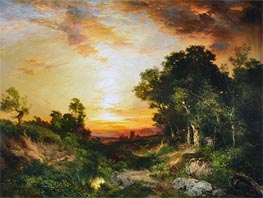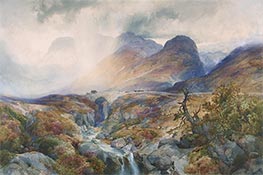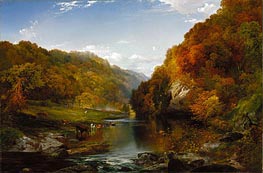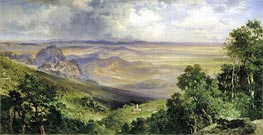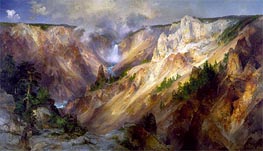Landscape Painting Reproductions - Page 163
Landscape painting is a genre of art that depicts outdoor scenes, such as mountains, forests, rivers, and gardens. The history of landscape painting dates back to ancient times, with examples from ancient Egyptian, Greek, and Roman art. During the Middle Ages, landscape paintings were mainly used as backgrounds for religious scenes, and it was not until the Renaissance that landscape painting emerged as a separate genre.
During the Renaissance, artists started to focus more on the natural world and began to experiment with perspective, light and shadow, and atmospheric effects in their landscapes. This period also saw the rise of topographical painting, which depicted accurate views of specific locations. During this time, artists such as Leonardo da Vinci and Albrecht Dürer produced iconic landscape paintings.
The 17th century Dutch Golden Age saw a trend towards landscapes that were more genre-like and less topographical, with scenes of everyday life and landscapes with rolling hills, waterways, and windmills. This period is also known for the development of the "Dutch light" style, which was characterized by a luminous, highly transparent quality of light and a preference for sunny skies. Painters such as Jan van Goyen and Jacob van Ruisdael became renowned for their realistic landscapes.
In the 18th and 19th centuries, Romanticism and the interest in the Sublime in art and literature led to a focus on dramatic, awe-inspiring landscapes. Painters such as J.M.W. Turner and Caspar David Friedrich used dramatic light, color, and form to evoke a sense of awe and drama in their landscapes.
The Impressionist movement of the late 19th century was characterized by its loose brushwork, light color palette, and emphasis on capturing the fleeting effects of light and atmosphere. Impressionist landscapes, such as those by Claude Monet and Pierre-Auguste Renoir, often depicted modern life, with leisurely scenes of parks, gardens, and the countryside.
Throughout the 20th century, landscape painting continued to evolve and diversify, with many artists pushing the boundaries of the genre through new styles and techniques. Some notable examples include the abstract landscapes of artists such as Mark Rothko and Joan Mitchell, and the photorealistic landscapes of Richard Estes and Ralph Goings.
Overall, landscape painting has a rich and varied history, reflecting the changing attitudes and perspectives of different cultures and time periods.
During the Renaissance, artists started to focus more on the natural world and began to experiment with perspective, light and shadow, and atmospheric effects in their landscapes. This period also saw the rise of topographical painting, which depicted accurate views of specific locations. During this time, artists such as Leonardo da Vinci and Albrecht Dürer produced iconic landscape paintings.
The 17th century Dutch Golden Age saw a trend towards landscapes that were more genre-like and less topographical, with scenes of everyday life and landscapes with rolling hills, waterways, and windmills. This period is also known for the development of the "Dutch light" style, which was characterized by a luminous, highly transparent quality of light and a preference for sunny skies. Painters such as Jan van Goyen and Jacob van Ruisdael became renowned for their realistic landscapes.
In the 18th and 19th centuries, Romanticism and the interest in the Sublime in art and literature led to a focus on dramatic, awe-inspiring landscapes. Painters such as J.M.W. Turner and Caspar David Friedrich used dramatic light, color, and form to evoke a sense of awe and drama in their landscapes.
The Impressionist movement of the late 19th century was characterized by its loose brushwork, light color palette, and emphasis on capturing the fleeting effects of light and atmosphere. Impressionist landscapes, such as those by Claude Monet and Pierre-Auguste Renoir, often depicted modern life, with leisurely scenes of parks, gardens, and the countryside.
Throughout the 20th century, landscape painting continued to evolve and diversify, with many artists pushing the boundaries of the genre through new styles and techniques. Some notable examples include the abstract landscapes of artists such as Mark Rothko and Joan Mitchell, and the photorealistic landscapes of Richard Estes and Ralph Goings.
Overall, landscape painting has a rich and varied history, reflecting the changing attitudes and perspectives of different cultures and time periods.
page 163 of 275
SKU: MOT-9295
Thomas Moran
Original Size: 27.3 x 41.9 cm
Private Collection
Thomas Moran
Original Size: 27.3 x 41.9 cm
Private Collection
SKU: MOT-9294
Thomas Moran
Original Size: 100.6 x 150.5 cm
Gilcrease Museum Tulsa USA
Thomas Moran
Original Size: 100.6 x 150.5 cm
Gilcrease Museum Tulsa USA
SKU: MOT-9293
Thomas Moran
Original Size: 50.8 x 76.2 cm
Private Collection
Thomas Moran
Original Size: 50.8 x 76.2 cm
Private Collection
SKU: MOT-9292
Thomas Moran
Original Size: 40.6 x 51.4 cm
Private Collection
Thomas Moran
Original Size: 40.6 x 51.4 cm
Private Collection
SKU: MOT-9291
Thomas Moran
Original Size: 31.1 x 25.4 cm
Private Collection
Thomas Moran
Original Size: 31.1 x 25.4 cm
Private Collection
SKU: MOT-9290
Thomas Moran
Original Size: 35.6 x 50.8 cm
Private Collection
Thomas Moran
Original Size: 35.6 x 50.8 cm
Private Collection
SKU: MOT-9289
Thomas Moran
Original Size: 40.6 x 50.8 cm
Private Collection
Thomas Moran
Original Size: 40.6 x 50.8 cm
Private Collection
SKU: MOT-9288
Thomas Moran
Original Size: 63.5 x 121.9 cm
Private Collection
Thomas Moran
Original Size: 63.5 x 121.9 cm
Private Collection
SKU: MOT-9287
Thomas Moran
Original Size: 76.2 x 114.3 cm
New Britain Museum of American Art Connecticut USA
Thomas Moran
Original Size: 76.2 x 114.3 cm
New Britain Museum of American Art Connecticut USA
SKU: MOT-9286
Thomas Moran
Original Size: 76.2 x 63.5 cm
Private Collection
Thomas Moran
Original Size: 76.2 x 63.5 cm
Private Collection
SKU: MOT-9285
Thomas Moran
Original Size: 74.3 x 48.9 cm
Private Collection
Thomas Moran
Original Size: 74.3 x 48.9 cm
Private Collection
SKU: MOT-9284
Thomas Moran
Original Size: 76.2 x 101.6 cm
Dallas Museum of Art Texas USA
Thomas Moran
Original Size: 76.2 x 101.6 cm
Dallas Museum of Art Texas USA
SKU: MOT-9283
Thomas Moran
Original Size: 82.5 x 125.7 cm
Albright-Knox Art Gallery Buffalo USA
Thomas Moran
Original Size: 82.5 x 125.7 cm
Albright-Knox Art Gallery Buffalo USA
SKU: MOT-9282
Thomas Moran
Original Size: 28.3 x 43.5 cm
Private Collection
Thomas Moran
Original Size: 28.3 x 43.5 cm
Private Collection
SKU: MOT-9281
Thomas Moran
Original Size: 35.6 x 50.8 cm
Private Collection
Thomas Moran
Original Size: 35.6 x 50.8 cm
Private Collection
SKU: MOT-9280
Thomas Moran
Original Size: 50.8 x 76.2 cm
Private Collection
Thomas Moran
Original Size: 50.8 x 76.2 cm
Private Collection
SKU: MOT-9279
Thomas Moran
Original Size: 101.6 x 167.6 cm
Private Collection
Thomas Moran
Original Size: 101.6 x 167.6 cm
Private Collection
SKU: MOT-9278
Thomas Moran
Original Size: 28.5 x 40.6 cm
Private Collection
Thomas Moran
Original Size: 28.5 x 40.6 cm
Private Collection
SKU: MOT-9276
Thomas Moran
Original Size: 77.5 x 103 cm
Private Collection
Thomas Moran
Original Size: 77.5 x 103 cm
Private Collection
SKU: MOT-9275
Thomas Moran
Original Size: 70.8 x 96.2 cm
Gilcrease Museum Tulsa USA
Thomas Moran
Original Size: 70.8 x 96.2 cm
Gilcrease Museum Tulsa USA
SKU: MOT-9274
Thomas Moran
Original Size: 180.3 x 335.3 cm
Gilcrease Museum Tulsa USA
Thomas Moran
Original Size: 180.3 x 335.3 cm
Gilcrease Museum Tulsa USA
SKU: MOT-9273
Thomas Moran
Original Size: 76.8 x 114.9 cm
Terra Museum of American Art Chicago USA
Thomas Moran
Original Size: 76.8 x 114.9 cm
Terra Museum of American Art Chicago USA
SKU: MOT-9272
Thomas Moran
Original Size: 35.9 x 68.9 cm
Smithsonian American Art Museum Washington USA
Thomas Moran
Original Size: 35.9 x 68.9 cm
Smithsonian American Art Museum Washington USA
SKU: MOT-9271
Thomas Moran
Original Size: 245.1 x 427.8 cm
Smithsonian American Art Museum Washington USA
Thomas Moran
Original Size: 245.1 x 427.8 cm
Smithsonian American Art Museum Washington USA
